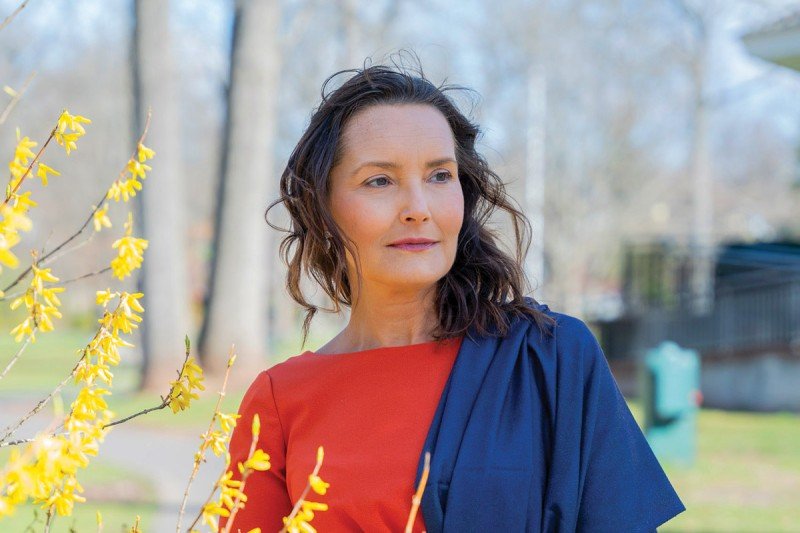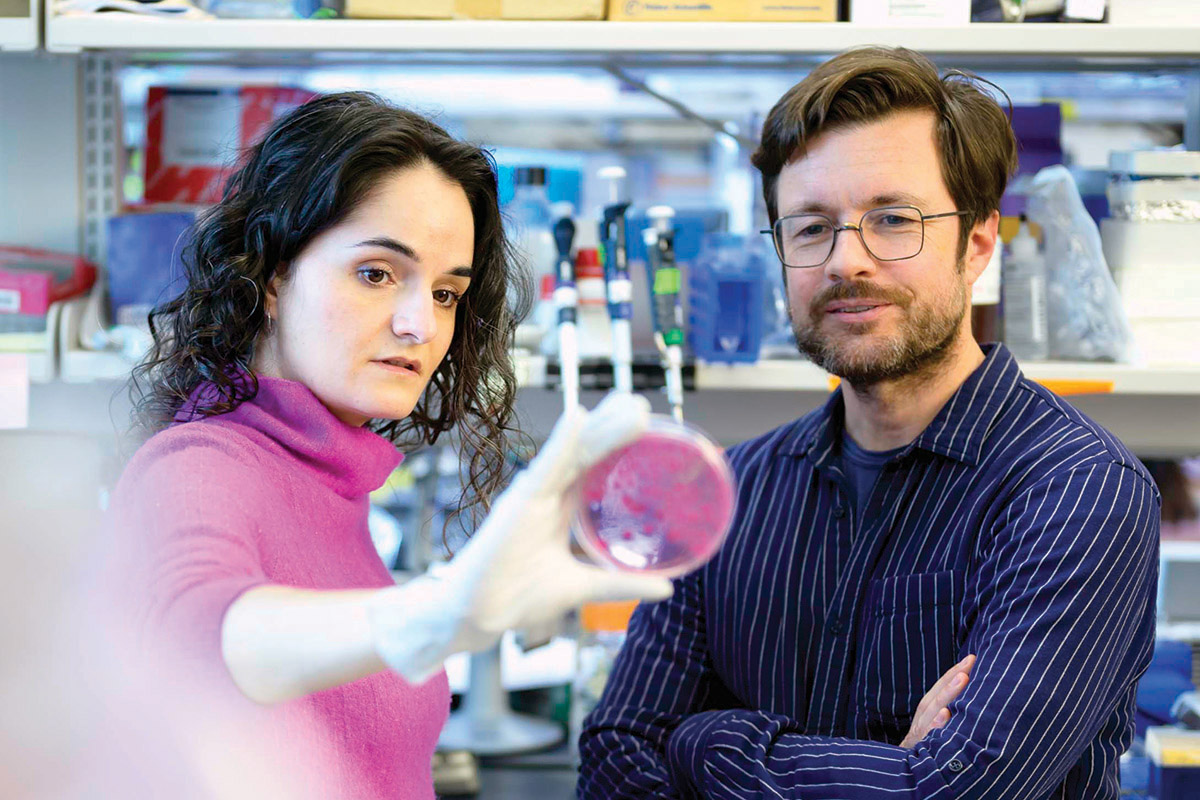
After learning she would need a cord blood transplant to treat her leukemia, Bridget Anderson decided to enroll in a clinical trial testing the benefits of fecal microbiota transplants.

After recovering from her cord blood transplant, Bridget Anderson, shown here with now-husband Charlie Gerstung, was finally able to travel to Red Rocks in Colorado.
Bridget Anderson had been looking forward to attending a concert at the Red Rocks Amphitheatre in Colorado with college friends. But a few days before her trip, she’d gone to her doctor in Newark, New Jersey, complaining about fatigue. Blood tests revealed devastating news: She had acute lymphoblastic leukemia.
“I was admitted on my 45th birthday,” she says. “Talk about putting the aging process in perspective.”
Bridget Participates in a Fecal Transplant Clinical Trial
She needed a transplant to replace her own blood stem cells, which were being destroyed by the leukemia. She was given a 50% chance of survival. She was also given the opportunity to participate in a study led by infectious disease expert Ying Taur testing the impact of manipulating the ecosystem of the microbiota in her gut. There is growing evidence that patients having stem cell transplant benefit from fecal microbiota transplants — known more commonly as poop transplants.
“When I learned I’d been selected for the test group of the trial, I told my boyfriend, Charlie, that I never in a million years thought I’d be rooting to have my feces put back inside me,” Bridget remembers.
This procedure may sound off-putting, but it’s a cutting-edge way to manage a critical system in the body. The microbiota is the ecosystem of microorganisms that swarm our gut, live on our skin, and thrive in our respiratory airways. This ecosystem plays a vital role in maintaining good health. In the gut, these bacteria train our immune system and help us obtain nutrients from our food, but they can also cause inflammation and suppress the immune system.
How Does Microbiota Health Affect Outcomes of Blood Cancer Treatments?
Because the microbiota is so important for human health, scientists at MSK are working to uncover the role the it plays in cancer treatment. Researchers throughout the institution are focused on how managing the microbiota can improve patient care as well as someday even potentially prevent certain cancers, like colorectal cancer, from ever developing in the first place. We’ve learned the microbiota can also impact how well a patient responds to treatments with immunotherapy. That makes sense, because about half of your immune cells live in your gut and are in contact with your microbiota.
Why Would an Oncologist Recommend a Fecal Microbiota Transplant?
“My doctors explained that when you have any kind of stem cell or bone marrow transplant, the treatment kills a lot of the healthy bacteria that you need in your gut,” Bridget says. “They thought that storing my healthy microbiota and later putting it back might reduce some of the side effects from the transplant. I thought, ‘Why not? I’ll give it a try.’ ”

Infectious disease doctor Ying Taur led a study looking at the benefits of fecal microbiota transplants.
Before she began her cord blood transplant in October 2015, a sample of Bridget’s stool was collected and frozen. Later, after she received chemotherapy and infusions of umbilical cord blood to replace her own blood stem cells, her stool was thawed out and its beneficial microbiota was returned to her body, where it could start repopulating her gut.
Always an optimist, she says, “I never once thought my cancer treatment would not be successful.”
MSK Discoveries into Managing the Microbiome of Transplant Patients
For more than a decade, Memorial Sloan Kettering Cancer Center (MSK) has been at the forefront of studying gut microbiota in people receiving stem cell and bone marrow transplants. This initiative has been led by physician-scientist Marcel van den Brink, a member of the Immunology Program at the Sloan Kettering Institute (SKI).
Dr. van den Brink and his team have now amassed biological samples and comprehensive records for more than 1,400 patients. “We have a wealth of clinical data on these patients, including every drug they took and, in some cases, even what they ate,” says Dr. van den Brink, who holds the Alan N. Houghton Chair. “Having all of these details allows us to do research that wouldn’t be possible anywhere else.”
Microbiota’s Role In Bone Marrow Transplants and Graft-Versus-Host Disease
Scientists have learned that the microbiota can be thrown out of balance by the large doses of antibiotics given to patients to protect against infections while their immune cells are wiped out during the transplant. They’ve also discovered that patients with a less diverse microbiota are more likely to suffer graft-versus-host disease (GVHD), a potentially deadly side effect in which the donor’s immune cells attack the recipient’s healthy tissues.
In The New England Journal of Medicine in 2020, Dr. van den Brink and his colleagues reported that the diversity of the gut microbiota can predict a patient’s survival after a stem cell transplant. The research — a multicenter study involving cancer centers in Germany, Japan, and North Carolina — showed that the link between bacteria in the gut and patients’ outcomes is important across the globe.
Figuring out which gut bacteria matter the most could be a game changer: It might help predict which patients will benefit from certain types of cancer treatment and improve care for more of them by adjusting their microbiota.
Microbes and Immune System Cells: A Complex Relationship
Teasing apart the complexity of the microbiome requires a lot of expertise and computing power. SKI systems biologist Joao Xavier develops mathematical models to untangle this complexity. In a landmark study in Nature in November 2020, Dr. Xavier and his colleagues showed for the first time how the gut microbiota directly influences the human immune system. “During bone marrow transplants, the immune system and the microbiota are both damaged,” Dr. Xavier says. “Being able to track their parallel recovery gives us a unique opportunity to test the associations between the two of them.”
Understanding how the microbiota teaches immune cells is the focus of research by SKI immunologist Gretchen Diehl. “A lot of what I’m interested in is how specific microbes regulate the immune system,” says Dr. Diehl, who holds the Catherine and Frederick R. Adler Chair for Junior Faculty.
Using mouse models, her team has discovered gut bacteria travel to the thymus — the organ that makes immune cells called T cells — and trains the cells to distinguish between friend and foe. Their research was published in Nature in May 2021.
Changes in the gut microbiota may also answer a major mystery in colorectal cancer: What’s behind the recent increase in the disease in younger people? “It’s possible that certain microbes activate signaling in the lining of the gut, which could promote cancer,” Dr. Diehl says. “It’s important for us to understand the more mechanistic interactions between microbes and the intestine to get at why this might happen.”

Systems biologist Joao Xavier (right), shown here with postdoctoral research fellow Ana Djukovic, combines computational and experimental approaches to study the microbiota.
Why Bridget’s Own Healthy Microbiota Improved Her Treatment Outcome After Blood Cancers
Bridget’s fecal microbiota transplant was autologous, which means that she was given back her own microbiota, which had been stored at the start of the study before she got her cord blood transplant. Studies at other hospitals have looked at the benefits of transplanting donor stool. But because people having BMTs are so susceptible to infections, MSK researchers wanted to take a safer route and avoid transferring potentially dangerous strains that could be present in donors.
“The gut microbiota is kind of a black box,” Dr. Taur says. “We don’t always know exactly what it contains or which individual species will be the most beneficial.”
MSK’s Expertise in Autologous Fecal Microbiota Transplants
In 2018, Dr. Taur and his colleagues published results in Science Translational Medicine that confirmed autologous fecal transplants help restore a healthy microbiota. A preliminary analysis suggests that people who received the fecal transplant after their stem cell transplant had lower rates of viral infections and graft-versus-host-disease. “Viral infections and GVHD are the top two complications that transplant patients face, and both are related to the immune system,” Dr. Taur says. “We know that the immune system does a better job of rebuilding itself in the presence of a healthy, diverse microbiota.”
Six months after her fecal transplant, Bridget learned that her gut had been successfully recolonized by healthy bacteria. Having her ecosystem back in balance helped her through her transplant journey, which took months. “Throughout the whole process, I really didn’t have any serious infections,” she says.
Research Focuses on New Ways to Preserve Healthy Microbes During Treatment
MSK researchers are looking at other ways to keep a healthy balance of microbes in people having transplants. There’s an experimental microbiota pill being tested by hematologic oncologist Doris Ponce and medical oncologist Miguel-Angel Perales, Chief of the Adult BMT Service. MSK physician-scientist Jonathan Peled played an important role in the design of this pill and the trial. Investigators are also studying whether more careful use of antibiotics during the BMT process can protect healthy microbes and prevent harmful ones from taking hold.
As always, future therapies will be driven by basic research discoveries at SKI into the trillions of microbes that affect our immune system — how it slows or accelerates cancer and responds to treatment.
Bridget Is Thriving After Her Cancer Treatment and Fecal Microbiota Transplant
It’s been almost seven years since Bridget had her transplant. Last August Bridget married Charlie Gerstung, the boyfriend who stayed by her side throughout her treatment.
She also finally made that trip to the Red Rocks Amphitheatre. “Amongst the mountains of the Colorado night sky on a summer night,” she told a group of transplant patients, “I closed my eyes and looked up to God and the universe and said, ‘Thank you.’ ”
Microbiome research at MSK is supported by Anthony B. and Judith W. Evnin and the Tow Foundation. Dr. van den Brink’s microbiome research is supported by the Peter and Susan Solomon Family Foundation and the Paula and Rodger Riney Foundation.






